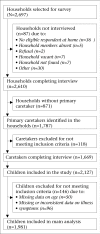Potential barriers to healthcare in Malawi for under-five children with cough and fever: a national household survey
- PMID: 24847595
- PMCID: PMC4089074
Potential barriers to healthcare in Malawi for under-five children with cough and fever: a national household survey
Abstract
Failure to access healthcare is an important contributor to child mortality in many developing countries. In a national household survey in Malawi, we explored demographic and socioeconomic barriers to healthcare for childhood illnesses and assessed the direct and indirect costs of seeking care. Using a cluster-sample design, we selected 2,697 households and interviewed 1,669 caretakers. The main reason for households not being surveyed was the absence of a primary caretaker in the household. Among 2,077 children aged less than five years, 504 episodes of cough and fever during the previous two weeks were reported. A trained healthcare provider was visited for 48.0% of illness episodes. A multivariate regression model showed that children from the poorest households (p = 0.02) and children aged > 12 months (p = 0.02) were less likely to seek care when ill compared to those living in wealthier households and children of higher age-group respectively. Families from rural households spent more time travelling compared to urban households (68.9 vs 14.1 minutes; p < 0.001). In addition, visiting a trained healthcare provider was associated with longer travel time (p < 0.001) and higher direct costs (p < 0.001) compared to visiting an untrained provider. Thus, several barriers to accessing healthcare in Malawi for childhood illnesses exist. Continued efforts to reduce these barriers are needed to narrow the gap in the health and healthcare equity in Malawi.
Figures
References
-
- Black RE, Cousens S, Johnson HL, Lawn JE, Rudan I, Bassani D, et al. Child Health Epidemiology Reference Group of WHO and UNICEF. Global, regional, and national causes of child mortality in 2008: a systematic analysis. Lancet. 2010;375:1969–87. - PubMed
-
- Victora CG, Wagstaff A, Schellenberg JA, Gwatkin D, Claeson M, Habicht J-P. Applying an equity lens to child health and mortality: more of the same is not enough. Lancet. 2003;362:233–41. - PubMed
-
- Stallings RY. Child morbidity and treatment patterns. Calverton, MD: ORC Macro; 2004. p. 134 p. (DHS comparative reports no. 8)
-
- National Statistical Office . Malawi demographic and health survey. Zomba: National Statistical Office 2011; 2010. p. 578 p.
MeSH terms
LinkOut - more resources
Full Text Sources
Medical
Miscellaneous


